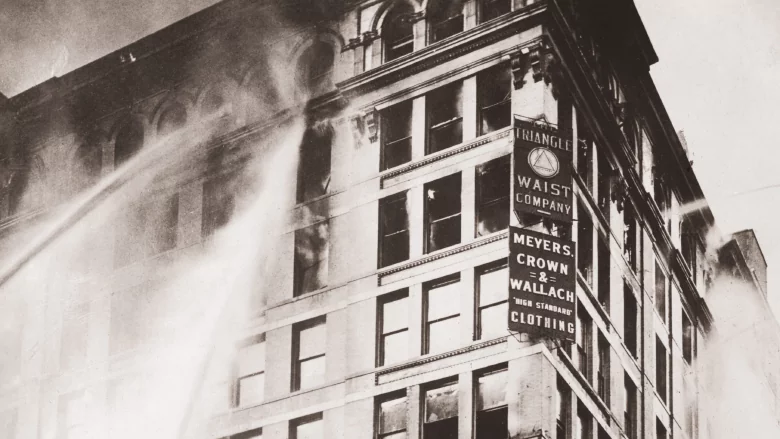
On March 25, 1911, a fire broke out at the Triangle Shirtwaist Factory in Manhattan killing 146 garment workers. The workers—most of them young, immigrant women in their teens and early twenties—were unable to escape due to locked doors and a lack of workplace safety precautions in the factory. (Exit doors were regularly locked to prevent workers from taking breaks, and there were no fire alarms to notify the workers.)
Thousands of people watched in helpless horror as the blaze absorbed the building, and workers desperate to escape the fire, jumped from the 9th floor onto their deaths. The fire galvanized people like Frances Perkins, an eyewitness who would later become the U.S. Secretary of Labor, to push for political reform.
The state of New York created the Factory Investigating Commission which inspected hundreds of factories for hazards. The findings led to sixty new labor laws including better building access, fire extinguishers, automatic sprinklers, and more. New legislation passed to shorten the workweek and improved the eating and restroom facilities for workers. Perkins would later guide Franklin D. Roosevelt to pass the New Deal which included landmark labor rights such as the 40-hour work week, minimum wage, and the right to unionize.
Seared on my mind as well as my heart—a never-to-be-forgotten reminder of why I had to spend my life fighting conditions that could permit such a tragedy.
Frances Perkins on the aftermath of the Triangle Shirtwaist Factory fire
The Triangle Shirtwaist Factory fire was a tragedy, but not uncommon in those days. About 100 workers died on the job everyday due to dangerous working conditions and a lack of government regulation that left workers vulnerable to the decisions of employers. Workers unionized by the thousands to demand change. The International Ladies Garment Workers Union (ILGWU) coordinated mass strikes, defied brutal beatings by police, all for the bare minimum of dignity at the workplace.
“The life of men and women is so cheap, and property is so sacred. There are so many of us for one job it matters little if 146 of us are burned to death… I know from my experience it is up to the working people to save themselves. The only way they can save themselves is by a strong working-class movement.”
Rose Schneiderman, a union activist, speaking on the need for union organizing at the memorial for the victims of the fire.
Organized workers led the demand for change at the workplace. Decades after the Triangle Shirtwaist Factory Fire, unions pushed for the passage of the Occupational Safety and Health Act of 1970 and the creation of the Occupational Safety and Health Administration (OSHA) which enforces a safety standard employers must abide by.
Though accidents and fatalities on the job are still a reality today, unions substantially lower the risk of workplace-related injuries. According to the U.S. Bureau of Labor Statistics, states that rank in the top 20 in union density have the lowest rates of workplace fatalities. Comparably, states with “right to work” laws which weaken union power have a 49% greater risk of workers dying on the job.
The labor reform that resulted from the Triangle Shirtwaist Factory fire is a blueprint for how union organizing and political activism work in tandem. “There’s a direct relationship between the ballot box and the bread box, and what the union fights for and wins at the bargaining table can be taken away in the legislative halls,” Walter Reuther, former UAW President. While unions lead the demand for change, it’s important to solidify these wins in the law, and then organize to continue to protect these rights. Unions continue to demand policies that protect workers and pursue safety and health protections on the job, setting the standard for workplace safety for all workers.
To find out more about safe working conditions, visit osha.gov.
